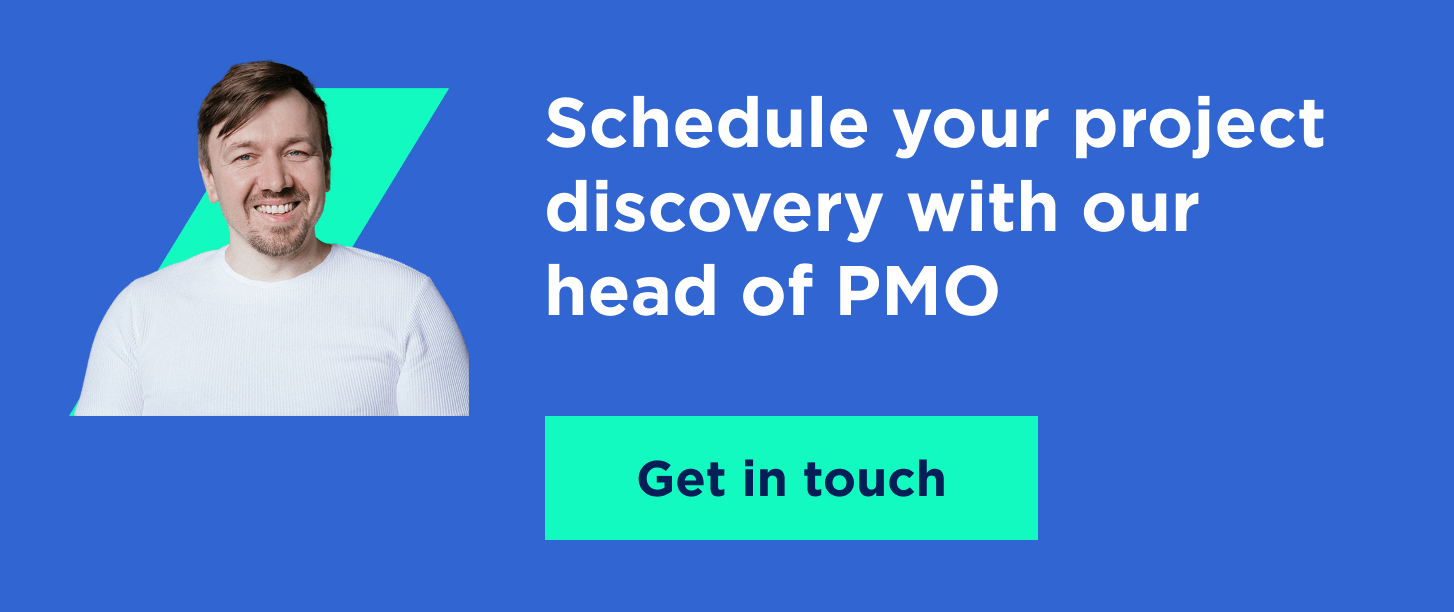So you have a business idea for a new product and sufficient funding. What next? Who’s going to bring it to life? What tech stack is right for you? Is it possible to develop what you have in mind at all? These questions are merely the tip of the iceberg for anyone hoping to launch a new product.
Getting a consultation with an experienced tech vendor is often the best first step to get a project off the ground. Consultations are also relevant if your product’s growth is set back by a lack of people with the required skills, crippling technical debt, or unresolved performance issues.
We at Lemberg Solutions hold frequent consulting sessions and know what tremendous effect they can have on product success, whether you’re a two-person startup or a large enterprise. Over the years, we have developed a thorough project discovery phase to help clients turn their ideas into income-generating projects in the most efficient way.
In this article, we’re going to share everything you need to know about discovery phases and their value in product development.

What is a discovery phase?
If you’ve never heard the term "discovery phase" before, you might have referred to it as ideation, concepting, or simply planning. In the context of software development, all these terms apply to the same process — developing the initial product idea into a clear understanding of its business goals, functional goals, and the efforts required for its implementation.
In fixed-cost projects, discovery is a best practice for initiating a project.
In agile projects, discovery establishes a high-level vision and scope of the solution to be developed and an initial milestone-based plan for its delivery.
Why is the project discovery phase important?
In the market economy, the value of something is determined by comparing the cost of implementing it and the risks of not implementing it — which outweighs the other? Having gone through a discovery phase, you’ll have no trouble answering this question.
Going beyond the basic justification “measure twice, cut once,” we prepared a list of benefits product owners reap by investing funds and effort into a project discovery phase and all the things that can go wrong if they don’t:
1. Get a realistic estimate, not a guesstimate
In addition to putting you and your development team or partner on the same page and completely transferring your vision to them, the output of the discovery phase defines the scope (either for the whole project or the MVP). Based on that, features can be estimated at a much higher level of accuracy.
Estimates produced without the discovery stage are largely referred to as guesstimates. If neither the product owner, nor the development team want to invest their time into preliminary discussions, the estimates will be based on assumptions and include significant risks. The higher the risks, the higher the uncertainty factor. A project discovery phase can help eliminate most of the uncertainty and reduce risks early in the process.
2. Validate the feasibility of your idea before development starts
Proofs of concept (PoCs) and prototyping techniques applied during the discovery phase enable product owners to confirm the technical feasibility of their ideas or specific product features before taking the project further.
Imagine how disappointing it would be to discover that some features are impossible to implement halfway through the project, after so much work has been done already. And what if the feature that turns out to be impossible is, in fact, the core feature of your product? Scary stuff.
3. Pick the right tech stack and development approach
During discovery, business analysts together with implementation experts assess your business needs and market requirements and make recommendations for the development approach. This way, your initial requirements can be complemented by the vendor’s technical knowledge and take into account the limitations and possibilities of the current technology state. This also includes getting professional recommendations about the most relevant tech stack that would suit your project’s needs.
Brainstorming can also lead to a discovery of new ideas or approaches and a combination of features that could transform your solution on many levels to best address your customers’ needs.
4. Partner with the best technical vendor
With a validated solution and defined scope (either full or for an MVP) in place as the outputs of the project discovery phase, a product owner can:
- share them with several technical vendors to receive a second opinion;
- compare offerings and choose the best vendor.
Without a clarified and documented scope, a product owner compares a set of numbers (which rarely represent the same things) from several vendors, and thus the decision they then make is based on fiction rather than fact. Different firms have different approaches to estimating, and you may fall into a trap with a vendor trying to lure you in by giving you bright yet unrealistic promises.
5. Receive an accurate time-to-market forecast
If you’re planning a major rollout, you have to arrange all the logistics well in advance and align the resources nicely so that all pieces of the puzzle come together smoothly as you progress. For this to happen, it is adamant to have your software product in the best form on time.
As the discovery phase results in clear scope and defined due dates, it grants you the highest chance of timely delivery. If the production starts without a defined scope and deadlines for milestones, getting your product to market is likely to be postponed time and again.
6. Prevent scope creep by defining and aligning scope
Fixed-cost projects. If your solution and its boundaries (what is in scope? what is out of scope?) have not been clearly defined at the beginning of the project, you’ll be at a high risk of struggling with scope creep (uncontrolled growth of project scope). And that inevitably leads to your timelines stretching ad infinitum.
This has to do with misinterpretation of requirements: even a minor difference in understanding at the beginning of a project can lead to frequent clashes with the development team about what is in or out of scope. A discovery phase is there to sync solution visions from the start, establish an effective process for change request management, and to prevent scope creep.
Agile projects. As the product vision evolves with each sprint, each new proposed feature is reassessed against the current business context to ensure that it will effectively align with business goals.
Without the initial product vision statement (and its documented evolution over time), it may be challenging to recognize the most relevant functionality.
7. Manage expectations
The outputs of the discovery phase set the bar for managing expectations from your end solution.
If all sides know what to expect from the project, in the end, the product owner is happy because they got a solution that meets their business needs within a reasonable timeframe and the expected budget, and the developers are happy because they delivered exactly what was expected of them.
Without syncing expectations from the start, the product owner and the software development team or vendor may end up having too many misunderstandings, which can then lead to mistrust, hard feelings, broken partnerships, and worst of all — lost time. A proper alignment early in the process via a discovery phase can help eliminate most of the uncertainty and keep risks at bay.
Bonus point: the additional value of the discovery phase for startups
When dealing with innovative ideas of startups, we combine discovery workshops with producing PoCs to validate the feasibility of product ideas early on. For startups, the deliverables of the discovery phase are also a significant credibility point during investor negotiations; wireframes produced during discovery can be used for early adopters' feedback. Generally, the whole exercise is a good start into the lean product development strategy.
Project discovery phase step-by-step
Now that you are familiar with all the benefits the product development discovery phase brings to the table, let’s take a closer look at the exact discovery phase steps you’ll have to take:
Step 1: Pre-workshop
Preparation is key to effective discovery. This step usually lasts about a week, but the client’s or product owner’s involvement doesn’t require more than 2-4 hours. The preparation involves the client’s request analysis, team engagement, and agenda planning.
Step 2: Discovery workshop
The discovery workshop takes from 2 to 4 days, with the client’s involvement taking about 4 to 6 hours every day. During workshops, projects get planned out to the tiniest detail, and all participants apply the very best of their expertise to think of ways to maximize project outcomes.
The rough agenda of a discovery workshop is laid out below, but the exact steps are usually defined for each project individually:
- Kick-off/intro meeting
- Business goals & needs discussion
- User persona definition
- Technical requirements elicitation
- Collaboration model discussion
- Summary and demo meeting
You’ll walk out of a discovery phase deliverables that include a defined project scope, tech stack, solution architecture, and budget and timeline estimations.
Step 3: Post-workshop
After the workshop, the discovery team will need about two weeks to finalize the plans. No more than 2 to 4 hours are usually required form the client. This stage is necessary to make sure everyone is on the same page in terms of project planning, deliverables, and further steps.
With all the essential preparations done, you can either present the results of the discovery to your own team or continue working with the chosen tech vendor to build your solution.
WoW: first-hand experience with the project discovery phase
Women on Wings (WoW) is a Dutch social enterprise aimed at increasing female employment in rural India. They provide training and consultations to help Indian businesses create more female-oriented jobs in forestry, agriculture, food production, and textile. The WoW team decided to create an intranet platform, using community software Open Social. Here’s how their project discovery journey went with Lemberg Solutions:
Stage 1: Pre-workshop
To understand their needs, analyze the core platform idea, and see if Open Social can work for it, we requested input materials, had a few discussions, and took a week to prepare for the workshop.
Stage 2: Discovery workshop
The WoW team visited us onsite for three days, which gave everyone enough time to brainstorm, discuss all available ideas, take a close look at the end user, analyze their needs, work out user roles and stories, ask questions and find common ground on the way the platform would have to look like. The purpose of this workshop was for everyone to dig deep into project options and needs.
Stage 3: Post-workshop
Our approach to tech consulting is quite simple: we rule out all the ideas that will not benefit your project, do extensive research and analysis, and give feedback. With this project, we settled on the best scenario to build the platform using Open Social, prepared a proposal and all the needed documents to get the project started. Among other things, our partners received a user types matrix, low fidelity wireframes, defined epics, and a ballpark estimation of the project. With that at hand, they decided to have our team not only help them in preparation but also build the platform from the ground up.

FAQ
Let’s recap the main points laid out in this article with a few frequently asked questions about discovery phases:
What is the purpose of the discovery phase?
The main purpose of the discovery phase is to develop a raw product idea into a clear development roadmap with defined business goals, functional goals, scope, tech stack, timelines, and budget.
Who is involved in the discovery phase?
The minimal discovery team includes the product owner, a business expert, a discovery moderator, a solution architect, and a technical expert. The ideal setup based on our experience looks like this:

What are the key benefits of a discovery phase?
- Realistic estimates
- Feasibility validation
- Defined tech stack
- Accurate time-to-market forecast
- Defined scope
- Aligned expectations between business and development
What happens if you skip discovery?
The main danger of skipping discovery is having scope creep and unreliable estimates for budget and timelines. The worst case scenario is realizing your project can’t be fully implemented at all halfway through development.
What is the duration of the discovery phase?
The discovery phase may last from several days to several weeks depending on project complexity.
What are the deliverables of the discovery phase?
- Defined project scope
- Tech stack
- Solution architecture
- Estimated budget
- Estimated timeline

Engage Lemberg Solutions for your project discovery
Here at Lemberg Solutions, we work with both startups and established businesses to help meet their business goals and deliver successful products. A professionally conducted discovery phase lays down the foundation for a product that is valuable, meets the market needs/business requirements and individual needs of all stakeholders, doesn’t exceed the planned budget and enters the market fast.
Complying with the best practices of business analysis, agile software development and lean startup ecosystem, Lemberg Solutions has established an effective discovery phase process with clear steps and deliverables. We’ll guide you through discovery to MVP and product launch all the way to maintenance and support. Reach out to get started!


